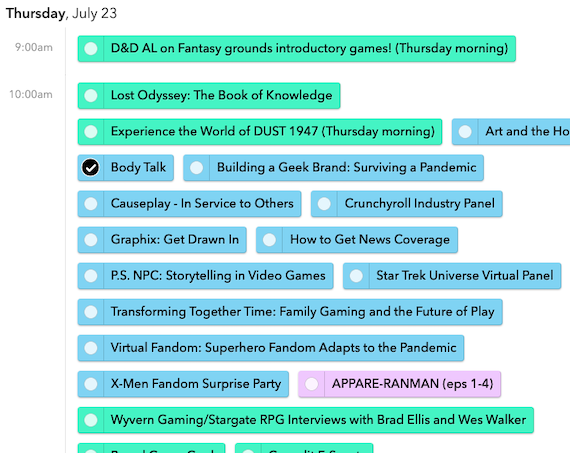Considering there are 15–20 panels in every block, these six are barely even a starter course for your Comic-Con@Home viewing. Hopefully these six will wet your whistle and get you excited for the plethora of amazing panels San Diego Comic-Con brought into our homes this year. What I thought would be a panel about how bodies are drawn on the page expanded to much more than that. It became a frank discussion on diversity and representation not only on the page, but in creative teams. These seven women discussed size, color, and transgender issues in terms of story, artists, and Own Voices writers with loads of passion and energy. The best thing about writing for Book Riot is being part of a bookish geek community. Both on the site and in the back channels, I always know that I’m among people who get me. So when I learned that Jordan Dené Ellis, co-editor of The Sartorial Geek (a community of which I am also a member), was moderating a panel on geek communities, I was in. It was fun sitting in on this conversation among geek community leaders who were clearly also actively involved in each other’s communities, and it was inspiring to hear about how, when they went looking for community and couldn’t find exactly what they were looking for, they felt empowered to create it. If nothing else, this panel is worth a watch just so you can find additional communities to plug into. —Steph Auteri Yes, this panel is a big marketing promo for Tor and its various imprints. It’s also one of the most high-energy, excited groups I saw amongst the various panels, making it one of my favorite San Diego Comic-Con panels. These four women were just SO EXCITED about the books coming out. It’s truly infectious in a good way. For anyone who’s a fan of sci-fi and fantasy, check this one out to get the dish on some great upcoming books. Not much mention was made of the source material for this upcoming HBO series (Matt Ruff’s Lovecraft Country), but watching this panel of cast members for sure made me want to reread it. The dark fantasy horror story follows a Black sci-fi fan and his family living in the Jim Crow–era United States. Hearing the cast talk about why this series is so vital at this time was powerful as hell. —Steph Auteri My absolute favorite genre of comics is kickass girls kicking ass, so when I stumbled upon this panel that was all about groups of girl friends who come together to make shit happen, I couldn’t believe my good luck. This panel was moderated by Sarah Kuhn, who wrote Shadow of the Batgirl, which completely charmed me when I read it. And she put together such a powerhouse panel! (Cecil Castellucci! Sam Maggs! Afua Richardson! Steenz! Rebekah Weatherspoon!!!) I could have spent forever just listening to them geek out about girl power, but what was really fascinating were their discussions on how they create authentic-seeming groups of girl friends and why they’ve been so motivated to do so. Give me more girl squads in comics, please! —Steph Auteri There were a number of panels this year that addressed the creation of comics and/or breaking in for aspiring comic creators. As one of the latter, I watched several of them, and this was my favorite. Brian Haberlin (Spawn, Witchblade, Sonata, adjunct professor for Minneapolis College of Art and Design) spent his hour giving an overview of creating a comic from pitch to publication. While much of his panel focused on art (panel arrangement, bleed and trim, etc.), the panel spends time on writing, pencils, coloring, and even lettering. He brought in a number of real-world examples, showing outlines, designs, scripts, and finished pages for existing works to illustrate his in-depth points.
